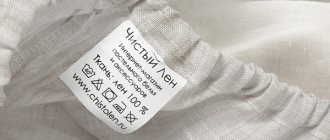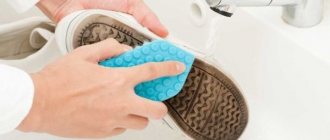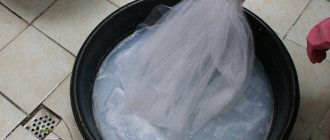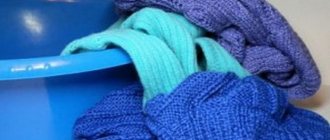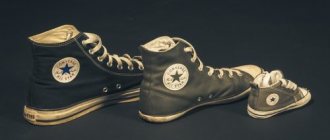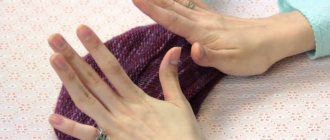There is a category of people who do not wear hats even in the most severe frosts in order to preserve their hair. Others think that hats don’t suit them. When a mother says to her child: “Put on your hat!” is a manifestation of love and care. Anyone who neglects to wear a hat in cold weather risks getting hypothermia of the head and throat. Also, walking without a hat has a negative impact on the condition of your hair.
In fact, choosing a winter or demi-season headdress with taste does not take five minutes, but the time spent is worth it.
Various configurations and styles, fur and knitted, designer and very simple, you can choose a hat to suit every taste and budget.
In addition, with the help of a headdress you can skillfully correct the shape of your face and then it will become your favorite decoration.
But, often, owners of beautiful hats are faced with another time-consuming and difficult task: how to clean a hat at home so that it does not lose its shape, color and size.
Why does this need arise? It happens that the dry cleaner does not take a product made from natural materials for fear of spoiling it. The condition of the scalp and oily hair can greatly stain the inside of the hat, and the product needs frequent cleaning.
Knitted hats
The hat, woven from synthetic threads, is washed in a washing machine, placing it in a special clothes bag. Choose a gentle mode and a temperature not higher than 30-35 degrees. It is better to choose a special liquid detergent. And thanks to the bag, the hat will not stretch. Do not use machine drying or spinning to prevent the product from losing its shape. Items containing natural ingredients cannot be washed in a machine, only by hand with shampoo or a specialized powder for wool and cotton threads. It is necessary to wash and rinse in cool water, no temperature changes. If the contamination is significant, the hat can be soaked for a short time by softening the water with vinegar. Pay attention to the chosen detergent; if it contains bleaching additives, then washing the hat in it is prohibited. The original color and appearance will be hopelessly damaged. Leave the washed item to drain and carefully blot it in a terry towel. Do not twist or wring out. After washing, a fluffy mohair hat is tied into a bag and placed in the freezer for several hours. As the water freezes, it forms ice crystals in the weave. Then the product is dried and acquires magnificent volume. If a wool hat has a distinct shape, it is usually a feminine piece matched to a coat. Dry the product in a stretched form, for example, on a jar of the appropriate diameter.
How to wash a wool scarf at home
Every housewife knows that a natural product is a delicate and delicate raw material. Over time or with improper care, clumps of fibers appear on the natural pile covering, attractiveness is lost, and the appearance becomes dull. Therefore, always pay special attention to cleaning methods and care.
The most common method involves using:
- basin, another deep container;
- cold water;
- soft brush or household sponge;
- neutral soap.
The process itself will not take much time and will not take much effort:
- Soak the scarf in a bowl of cold water. Leave it for an hour. During this time, the fiber will soften and be ready to remove dirt. To remove dirty stains and grease, you cannot do without washing. The soap should be of a mild variety. Natural materials do not withstand the effects of chemical elements.
- Pour boiling water over soft soap and mix thoroughly.
- Dip a brush or sponge into the dissolved soap, wipe the dirty area or grease stain with it. Do not apply unnecessary force, otherwise pellets may form. Treat not the entire area, but the most problematic areas and parts.
- After everything has been treated with soapy water, wring it out effortlessly and massage lightly.
- Fill the container with warm, clean water. Rinse several times. Change the liquid as it becomes full of soap residue.
- Finish the process only when there are no soap traces in the basin.
If you understand how to wash a wool scarf, you should listen to how to dry it. To do this, wring it out without much effort and spread it on a table or other horizontal object. Leave until completely dry.
Read about how to wash a down jacket so as not to throw the product away after washing.
Hat with pompom
If the pompom is knitted, then it is washed together with the hat, and after drying, combed using an animal hair comb. Stuck threads are pulled out with a knitting needle. You can’t do this with a fur pompom; it is torn off and sewn onto a clean base. Sometimes this is not possible, but it doesn’t matter. Cover the fluffy pompom with a thick plastic bag and tie it tightly so that water does not penetrate under the bag. Carefully wash the hat itself by hand, rinse, dry, untie the pompom and shake the product.
Color matters
Felt products of dark colors must be cleaned using tobacco decoction: 1 tbsp. l. leaves per 1 liter of water. Moisten a rag in the resulting liquid and gently wipe the stains. The only drawback is that the smell of tobacco remains. You will have to air out the hat for several days.
Felt products in light shades must be cleaned with bran. They need to be rubbed into the fabric and shaken out on the other side by tapping.
Do not use products designed to remove stains from white felt on a colored product. The stain remover should match the color of the hat.
Mink hat
A natural mink hat cannot be washed in the usual way. The thing is that both large sheets of fur and strips are greatly stretched during production. If you intensively wet the inner surface of the fur, the skins will wrinkle when drying, deforming the product. If the hat gets your hair dirty, it means it's pretty dirty. Sometimes it is enough to tear off the lining and wash it. Or replace it with a new one. Then they inspect the product from the inside, checking for holes and moth bites. Fix problems, if any, extending the life of the device. Fur is conditioned only with natural ingredients, for example, wheat bran. Take two glasses of bran and brew with an equal amount of boiling water. Leave for a few minutes, drain off excess moisture and begin cleaning. Gently and carefully rub the wheat mass over the fur, not missing a single fragment. Then comb with a comb and shake. The fur item is dried by stuffing it with fabric or wrinkled soft paper.
Cleaning from dirt
It is better to take an expensive branded hat made of thin felt to the dry cleaner along with the instructions that come with it. Because you can clean heavy dirt or stains only when you are sure that you won’t spoil anything. A hat made of thick felt can still be cleaned from dirt and stains yourself. But the elegant white hat may not withstand experiments.
Advice In any case, no matter what you use to clean the hat, apply your chosen product to the inner, most inconspicuous part and see how the material behaves.
Now let’s look at what other available tools will help you clean your hat at home.
Cleaning with soapy water
If the hat has not been properly cared for and is already dusty and dirty before it gets wet, matters become more complicated.
Make a soap solution (LOC from Amway is best - it does not leave streaks). Dilute a few drops of the product in water (Lok should be added to water, and not vice versa, so as not to foam too much).
- Apply with a sponge over the entire surface and leave for several minutes.
- Using a hard sponge or soft brush, rinse with light movements.
- Rinse off with clean water. You can use water from a shower head, but very quickly. Do not keep under running water, there is no need to rinse thoroughly.
- Shake off excess moisture.
If necessary, correct the shape with your hands or use a special hat block (if you are the lucky owner of one) or a jar and leave it to dry.
It is not advisable to use washing powder or a solution of simple soap, since to wash it off you will need to literally rinse the hat in water. After this, it will be extremely difficult to return it to its original shape.
Ammonia
- Most stains on a felt hat come off with ammonia. Contaminated areas are wiped with its solution.
- You can use tobacco infusion (for dark felt).
Both can leave a persistent, unpleasant odor. Leave it to air in the fresh air without trying to overpower it with perfume. The mixture turns out to be deadly. It's better to air it out first.
Ammonia perfectly breaks down most types of contaminants. Most types of stains lend themselves to it. Usually, ammonia is enough for felt; there is no need to prepare complex compositions for removing stains. It can be mixed with semolina, bran, starch. Thus, mechanical cleaning is added to the properties of breaking down grease stains.
Modern stain removers such as Vanish can cope with complex stains on felt, but it is better to first check the reaction on the inside of the crown.
Felt hats
Berets and felt hats in light shades are cleaned of sweat and dust stains with the following solution. Mix five tablespoons of acetic acid in equal quantities with ammonia. Add one and a half tablespoons of salt to the resulting liquid and stir. Then soak a clean, non-fading rag with the resulting mixture and carefully clean the sensitive material. Wipe dry.
Clean greasy and greasy areas with a cotton pad soaked in purified gasoline. When dry, the product does not smell of anything.
In general, felt hats get dirty very quickly and look untidy. In order not to wait for such drastic measures, the hat is updated every two weeks. Steam the felt over a boiling kettle and remove dirt with a dry brush.
Useful tips
Before washing, treat contaminated areas with soapy water. This will simplify the general cleaning process.
Talc or starch will help renew the whiteness of light-colored products. Lightly sprinkle the hat with powder and wait 15-20 minutes, then shake it out thoroughly.
To protect hats made from natural materials from moths, use special products or sachets during storage.
Fur can only be combed with a wooden comb. In this case, you need to act carefully and carefully so as not to tear the pile out of the adhesive base.
For any material, hand washing is the safest way. The machine should be used only as a last resort in case of severe contamination.
Products made from genuine leather
Hats and caps can be made entirely of leather or with leather inserts. It will cost a tidy sum of money to have them cleaned by a cleaning service. Thrifty owners of expensive items clean such hats with onions. To do this, cut off a wide onion ring and rub the cut on the product. As the bulb becomes dirty, a new layer is cut off. Then the leather product is sent to the balcony to air. The shine and cleanliness are amazing.
The hat got caught in the rain
If your hat is soaking wet, you have a problem. It is unlikely that you will find a special blank in your house, so a three-liter jar, turned upside down, will do. This way the hat is less deformed when drying. You can also pull a round hat onto a ball of a suitable size or use an inflatable balloon.
Although dry felt repels water, prolonged exposure to a damp environment or rain will not do it any good. Heavy rain will soak through the thickest felt in a few minutes.
- No matter what kind of rain (drizzle or drizzle) your hat gets caught in, take care of it as soon as you get home.
- Shake off by hand.
- Brush off any remaining moisture and leave to dry near a heat source. Use a three-liter jar to prevent the brim of your hat from drooping. At home, this is the most affordable way to keep in shape.
- After drying, the brim and crown can be smoothed with a brush in the direction of the pile.
How to extend the service life before washing
You need to protect your fur and wool items from moths. To do this, in the closet where hats are stored, they lay out means to protect against an unexpected guest. This could be orange peels or orange essential oil. Lavender, mint, eucalyptus or geranium oil will also repel moths. Saturate pieces of fabric with aroma and place them in the corners of the shelves. You can place an open vessel with oil where it will not fall.
If the long fur of the product gets very wet due to snow, it should be dried with a hairdryer; the battery can ruin the color and reduce the life of the hat.
The same applies to washing; fur items should not be hung near heaters. But be sure to shake and comb with a wide-tooth comb.
Hair stains the inside surface of hats, so you should not forget about head hygiene during the cold period. If frequent washing with water is undesirable, then you can use dry shampoo or talcum powder for the scalp. Do not overuse styling products.
So, a hat is not a luxury, but a necessary part of every person’s wardrobe. We all want to be beautiful, clean and neat. Therefore, we stock up on wheat bran for cleaning a mink hat, and look for potato starch in the kitchen supplies for cleaning fur. We take gasoline from the garage, which is necessary to clean grease stains on felt fabric.
First stage of cleansing
There are reliable methods that can effectively remove stains from a fur hat. In most cases, it does not make much difference what kind of fur is used - the methods are suitable for mouton, mink, arctic fox, etc.
Before you wash your fur hat at home, you need to figure out how dirty it is. If there are lumps of dirt, deeply embedded, or matted fibers, then mechanical cleaning is required and only then use chemicals.
Mechanical cleaning is carried out using a stiff combing brush. Before brushing the Arctic fox, which usually has fur, you need to wrap a little cotton wool around the brush. This will protect the bottom layer from being pulled out without preventing dirt from being removed.
A product with short pile is best cleaned of dust using wet gauze. The entire surface of the headdress is covered with gauze, and then dust and small dirt are knocked out by patting the inside. They settle on gauze and make it possible to easily carry out chemical exposure.
It is recommended to remove the yellow coating that periodically appears on the surface of a light fur garment. For this, regular potato starch or talc is used. The powder product is applied to the entire product and thoroughly rubbed into the hairs. After a few minutes, you need to shake and knock out the remaining powder by patting the inside with movements. At the end of the procedure, comb with a stiff brush.


